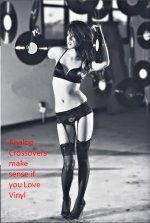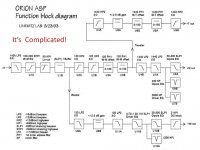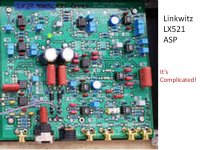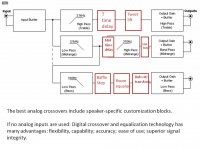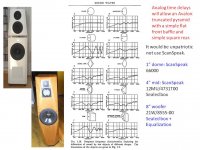If you Love Vinyl, an analog crossover is a good solution.
If you want the simplicity of plugging in an iPOD, an analog crossover is a good solution.
Perfectionist analog crossovers require many complex filter blocks, and still cannot provide the flexibility and performance of modern digital crossovers. If the majority of your music is digital bits, a shift to digital crossovers and D-A conversion for each amplifier is in your future.
Since an analog crossover cannot tweak a speakers SPL at each frequency, selecting drivers with very flat SPL response is important for the best sound.
Since you live in Sweden, it would be unpatriotic not use ScanSpeak.
1” dome: ScanSpeak 66000
4” mid: ScanSpeak 12MU/4731T00 Sealed box
8” woofer: ScanSpeak 21W/8555-00 Sealed box
+ Equalization
If you want the simplicity of plugging in an iPOD, an analog crossover is a good solution.
Perfectionist analog crossovers require many complex filter blocks, and still cannot provide the flexibility and performance of modern digital crossovers. If the majority of your music is digital bits, a shift to digital crossovers and D-A conversion for each amplifier is in your future.
Since an analog crossover cannot tweak a speakers SPL at each frequency, selecting drivers with very flat SPL response is important for the best sound.
Since you live in Sweden, it would be unpatriotic not use ScanSpeak.
1” dome: ScanSpeak 66000
4” mid: ScanSpeak 12MU/4731T00 Sealed box
8” woofer: ScanSpeak 21W/8555-00 Sealed box
+ Equalization
Attachments
1” dome: ScanSpeak 66000
4” mid: ScanSpeak 12MU/4731T00 Sealed box
8” woofer: ScanSpeak 21W/8555-00 Sealed box
+ Equalization
That would be my list if I could afford them - Great choice of drivers.
sreten, thanks for the pointer on achieveing the correct acoustic slope. I guess what that means is that a P09 only works as a true LR4 acoustically if the driver is flat an infinite number of octaves beyond the crossover point, which no driver is of course. My experience from my existing P09 filter is that the breakup of the midwoofer (which is indeed quite significant on the 8545k, is far enough from the crossover point to give decent results. I will however revisit my previous design and do some tweaking just for fun. I have an adjustable parametric equalizer that I implemented once that I can use for tweaking notches.
Since you live in Sweden, it would be unpatriotic not use ScanSpeak.
Well - ScanSpeak has never produced anything in Sweden. ScanSpeak is still in Videbaek in Jutland the western part of Denmark. BUT for how long - only time will show! ScanSpeak is now owned by Eastern Asia Technology Ltd. (HK) as of 1th of April this year.
There is no real reason to support ScanSpeak just because it's in Denmark - Is the drivers the right of the project - that's the question.
Regards,
Robert GS
A note regarding the P09 PCB: it is an excellent platform on which can be assembled ANY order of filter of ANY type, just by adding or eliminating stages and using different value components. It does NOT need to be built as only LR4, and in many cases, despite what Elliot and many others claim, that filter will not provide optimum results. Right now I am running mine as BW 2nd for high pass (single opamp stage) and BW 4th for low pass. I imagine you could build even higher than 4th order, if that was necessary, by stringing more stages together. There is plenty of flexibility on that PCB.
The P09 kit is not perfect (I think it is too cheaply made and the pads lift easily), but it is the cheapest kit available if you just use your imagination and learn a little about active filters. If you're going to be experimenting, buy a couple spares to save additional shipping, which is almost as much as the boards. Don't stop reading when you get to the end of Elliot's article, and don't believe everything he writes!
Peace,
Tom E
The P09 kit is not perfect (I think it is too cheaply made and the pads lift easily), but it is the cheapest kit available if you just use your imagination and learn a little about active filters. If you're going to be experimenting, buy a couple spares to save additional shipping, which is almost as much as the boards. Don't stop reading when you get to the end of Elliot's article, and don't believe everything he writes!
Peace,
Tom E
... in many cases, despite what Elliot and many others claim, that filter will not provide optimum results...
I am using the P09 with OPA2604 and WIMA polypropylene capacitors, otherwise I am basically following Rods recommended setup for a 2-way. I am using Rods preamp power supply kit. Do you have any partcular pointers as to how the P09 does not perform optimally? Circumstances or components to avoid or general design flaws?
I meant only that the LR4 electrical slopes might not be the best for all combinations of drivers. Many have pointed out here and elsewhere that LR4 is not always ideal. There is nothing wrong with the way P09 implements LR4, or any other xover configuration.
My point is that LR4 is not the only configuration available from the P09. If LR4 works for your speakers, that's great.
Wima are decent caps, but not the best for high pass because of magnetic leads. I have found some polystyrene caps sound better and have non-magnetic leads. Wima are great for low pass.
Cheap metal film resistors with magnetic leads can also affect the sound of mids and highs, but not as much as caps.
Opamp selection is somewhat of a personal choice. I tend to mix a couple different kinds within the circuit so as to avoid the dominant sound of multiples of any individual chip. So I use one type for input and another type within the high pass filter and yet another type within the low pass filter.
Peace,
Tom E
My point is that LR4 is not the only configuration available from the P09. If LR4 works for your speakers, that's great.
Wima are decent caps, but not the best for high pass because of magnetic leads. I have found some polystyrene caps sound better and have non-magnetic leads. Wima are great for low pass.
Cheap metal film resistors with magnetic leads can also affect the sound of mids and highs, but not as much as caps.
Opamp selection is somewhat of a personal choice. I tend to mix a couple different kinds within the circuit so as to avoid the dominant sound of multiples of any individual chip. So I use one type for input and another type within the high pass filter and yet another type within the low pass filter.
Peace,
Tom E
Last edited:
Do you have any particular pointers as to how the P09 does not perform optimally? Circumstances or components to avoid or general design flaws?
No design flaws. Just that it is like a ready-made all-purpose passive crossover (if you know what that means).
Read Linkwitz Lab - Loudspeaker Design if you want to know more.
No design flaws. Just that it is like a ready-made all-purpose passive crossover (if you know what that means).
Read Linkwitz Lab - Loudspeaker Design if you want to know more.
This is so wrong. I wonder how much you even know about P09. It is nothing like a ready-made passive xover.
First of all, it is active, so it does not require the sometimes complex combination of components to account for frequency dependent characteristics of most drivers that affect how passive xovers operate. This greatly simplifies the design and operation of any active xover.
Second, it does not reduce dynamics and gain of the amplification portion of a system. In fact, P09 can easily ADD gain to a system if you require it.
The only way it resembles a packaged passive is that, if you follow Elliot's instructions and calculations, you will obtain an accurate and well-understood fixed xover slope and crossover points, and you will know that individual driver properties have no affect whatsoever on its operation. The xover is as flexible as you are able to make it. If you have no knowledge of active filters or their implementation, then, yes, it can be like any other kit.
Peace,
Tom E
Well - ScanSpeak has never produced anything in Sweden.ScanSpeak is now owned by Eastern Asia Technology Ltd. (HK)
Favorite Combination of SB Acoustics Drivers for 3cuft (H=42,W=11,D=11) 3-way:
---Estimate 85db/watt with normal baffle step compensation.
--- $205 for 3 drivers
SB29RDNC-C00-4 tweeter $55 2" diameter case = short C-to-C
SB15NRXC30-8-UC Le=0.16mH. $55 0.1 cubic foot sealed box for F3 of 95Hz
---uses uncoated Papyrus Cone
---this 5" from LR4 100Hz to LR4 1800Hz covers the vocal range
SB23NRX45-8 8" woofer $95 Le=0.6mH. only 88db@2.83V
---Ported in 2.7cuft f3=28Hz ..... build with optional port(below)
---Sealed in 2.7cuft f3=43Hz Qts= 0.57 ~Bessel
---Sealed in 1.4cuft f3=52Hz... Add f3=20Hz Linkwitz Transform
---Estimate 85db/watt with some baffle step.
NOTE: The small physical size of the SB29RDNC tweeter allows the same C-to-C distance with a 5" midrange, as compared to a 3"-4" diameter dome tweeter with a 4" midrange.
If you want a 4" use the SB12MNRX25-4 $55. The SPL response is very flat and extended.
This is so wrong. I wonder how much you even know about P09. It is nothing like a ready-made passive xover.
Just show me a circuit from the internet, then I will tell you if I haven't built it.
It is nothing like a ready-made passive xover.
If you have no knowledge of active filters or their implementation, then, yes, it can be like any other kit.
I treat my active crossover design just like amplifier design and passive crossover design, in that, there is no "standard" circuit because it is designed for specific system/drivers. It is not even modular like Linkwitz approach because I try to minimize the use of opamp. It is a combination of many things (PLLXO, gyrators, opamp-based HPF/LPF, line-level inductor, passive filter and even enclosure design to shape the roll-off along with Linkwitz transform).
Text-book crossover works on perfectly flat FR before and after the crossover frequency, which is not the actual situation is.
and in many cases, despite what Elliot and many others claim, that filter will not provide optimum results.
Just make up your mind, or focus on the topic.
My speakers are bi-polar 3-ways using HiVi RTi tweeters, Dayton Dome Midranges, and Vifa TC14(Recession busters bottom)
They are crossed with an LR4 at 5khz and 500hz using a minidsp. They are powered by a 4x100w Sure Electronics chip amp using a Meanwell 24v power supply.
I used a minidsp Umik to voice to level match, compensate for BSC, and provide general EQ etc
The construction started with a 13-ply exterior lined with peel-n-seal roofing material on the inside and 1/2" ply for constrained layer damping and mass panel loading. The 1/2" interior panels are rib braced with 1" x 2" Texas red oak at around 3" intervals. The corners were rounded over and glue up was done using PL Construction adhesive. I stuffed the interior with grill cloth wrapped mineral wool. Originally I tried to build an interior box first, but it was a disaster.
I hope that gives you some ideas of your own.
They are crossed with an LR4 at 5khz and 500hz using a minidsp. They are powered by a 4x100w Sure Electronics chip amp using a Meanwell 24v power supply.
I used a minidsp Umik to voice to level match, compensate for BSC, and provide general EQ etc
The construction started with a 13-ply exterior lined with peel-n-seal roofing material on the inside and 1/2" ply for constrained layer damping and mass panel loading. The 1/2" interior panels are rib braced with 1" x 2" Texas red oak at around 3" intervals. The corners were rounded over and glue up was done using PL Construction adhesive. I stuffed the interior with grill cloth wrapped mineral wool. Originally I tried to build an interior box first, but it was a disaster.
I hope that gives you some ideas of your own.
- Status
- This old topic is closed. If you want to reopen this topic, contact a moderator using the "Report Post" button.
- Home
- Loudspeakers
- Multi-Way
- 3-way design ideas wanted!
